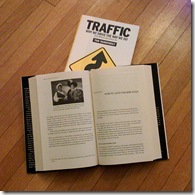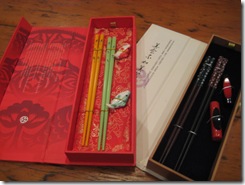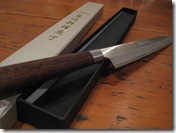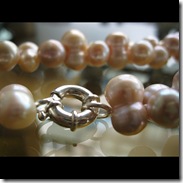[Guest Blogger] Product Potluck from Waterloo UX Group
Apparently, I missed an exciting Product Potluck while I was away in China. Last month the Waterloo User Experience Group had a meeting where people brought in an everyday product to discuss their design issues with the group. It was such an interesting concept for a user group meeting that I had to find out more. Gordon Varney, director of Software Development at Metavera, has kindly offered to write an event summary. So, let’s enjoy the potluck summary from Gordon. :)
January Product Potluck
At the January 22 UX Group meeting in Waterloo, people brought along a favoured or hated product to discuss. An interesting experience. Here are some highlights from the discussion.
Books
 Mark Connolly began by thumping a book onto the table. Actually two hardcover non-fiction books, with slipcovers, about one inch thick and full of words, not surprisingly. They had few, if any, pictures, a table of contents and an index.
Mark Connolly began by thumping a book onto the table. Actually two hardcover non-fiction books, with slipcovers, about one inch thick and full of words, not surprisingly. They had few, if any, pictures, a table of contents and an index.
Books have been around for so many years that the kinks have universally been worked out. Attempts to “improve” the classic norms are generally disastrous: we expect page numbers to be on the outside edge, for example. Putting the page number in the gutter might seem novel but it fails the reader. We talked about the value of the table of contents and the index, but also about other aspects. It’s easy to bend over a page corner or slip in a scrap of paper to indicate a page of importance, or to write notes, or to skim or skip sections of little interest. Visible wear and tear communicates historical information on how a book has been used. Just by noticing where your current page is, you have a notion of how far you have gone and how far you have to go. We talked about the various binding methods and how some were better for some audiences. The dust jacket was a point of contention. (Photo by Mark Connolly)
Eyeglass frames
Adam Meghji shared his experience with a new pair of eyeglasses from ic! Berlin. These frames are made from spring steel and are incredibly flexible and apparently virtually indestructible. They have no hinge per se and can be easily twisted apart and restored (with a practiced flick of the wrist.). Just wonderful for someone wearing them for sports or for a parent prone to rolling around with the kids. Stylish, lightweight, what more could you want? Well, one thing: while they do fold up, once folded, they are very likely to spring open — and to launch themselves across the room. Oops. Check out this YouTube video of these impressive frames.
Necklace clasp
Next up, Kate Wringe demonstrated the clasp of her necklace. Likely everyone has fumbled with a necklace clasp at one time or another. Like books, necklace clasps have been around for a long time. Nobody could recall a better clasp than the standard sliding-circle mechanism on this particular necklace, but everyone agreed that trying to fasten one of these things behind your head, usually while you are in a hurry, is far from a simple procedure. Maybe the designers assumed that you’d have someone else available to do it for you.
The design’s affordances communicated well what you should do to fasten or unfasten it. That wasn’t the issue. The issue was that the clasp itself is very small. Our fingers in comparison are huge, and in many cases it is an action that needs to be done out of sight. Compare this to bracelets, where you get to see what you are doing; however, you have the additional challenge of trying to do it one-handed. (Photo by shapeshift)
Chopsticks and sushi knives
 Robert Barlow-Busch seeded the last discussion with several pairs of chopsticks. Talk then moved on to a sushi knife, side tracked to Apple and Steve Jobs, and somehow ended up with a demonstration of the latest RIM Blackberry.
Robert Barlow-Busch seeded the last discussion with several pairs of chopsticks. Talk then moved on to a sushi knife, side tracked to Apple and Steve Jobs, and somehow ended up with a demonstration of the latest RIM Blackberry.
The chopstick discussion began with universal agreement that (for us at least) learning to use them efficiently was a challenge, involving much trial and embarrassment, something not to be mastered quickly. The notion of “friction” in a user experience, however, was discussed as something that can be beneficial, as a way to provide feedback indicating when you’re on the right track. Further, it’s okay for an efficient interface to be slightly difficult at first, as we often enjoy overcoming challenges while learning new skills (for example, why learn to drive a standard transmission when automatic is so measurably easier to learn?). 
Our attention then turned from the chopsticks themselves, which were beautifully decorated, to the packaging. They were in elegant boxes that communicated a real sense of quality and contributed in large measure to a feeling of pride of ownership. That led to a discussion about the ability of a sushi knife to be sharpened razor sharp, complemented by excellent balance and, again, exceptional packaging. (Photo by Robert Barlow-Busch)
Talk of boxes flowed naturally into matters of a product’s “out-of-box experience”, something that Apple has perfected. That led us to the iPod Touch, then the iPhone, which led to the BlackBerry and the Storm in particular, which led to the unfortunate deletion of all the contacts from Keith Balasingham’s BlackBerry as it was passed around. Ok, I don’t think we deleted any contacts, but it was tempting. :-)
 Gordon Varney, Director of Software Development, Metavera
Gordon Varney, Director of Software Development, Metavera
Gordon has over 25 years of involvement with companies based in Waterloo Region, such as Open Text, Automation Tooling Systems (ATS), and Descartes Systems Group. He is familiar with the early life cycle period of software development companies and their challenges.
Following graduation with Electronic Engineering from Conestoga College, Gordon went on to study business at Wilfred Laurier University: he has the ability to bridge the technology/business gap. Gordon was a Director at the University of Waterloo's Centre for Professional Writing and maintains a very close relationship with the UW Co-operative Education department.
Recently he was the VP of Research at the Canadian Innovation Centre, a market research firm specializing in assessing innovation and new technology opportunities to gauge their commercialization risks for the National Research Council of Canada (NRC) and Technology Transfer Offices of Universities across Canada. Gordon's specialty at the CIC was software and electronic technology.
Gordon is or has been active in the Project Management Institute (PMI), Society for Technical Communications (STC), and the American Society for Quality Control (ASQC).
Technorati Tags: UX Design,Product Design,Waterloo UX Group
Comments
- Anonymous
February 09, 2009
PingBack from http://www.clickandsolve.com/?p=5508
